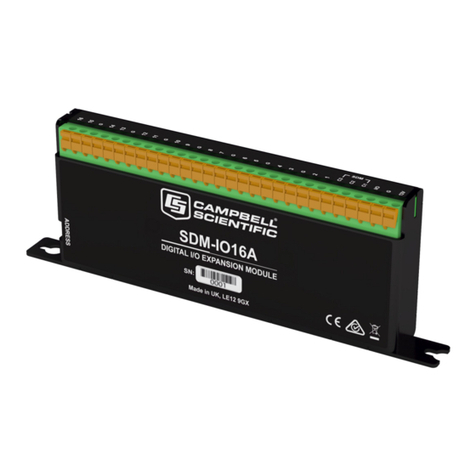
CR23X MICROLOGGER OVERVIEW
OV-4
The 9-pin serial CS I/O port provides connection
to data storage peripherals, such as the
SM192/716 Storage Module, and provides
serial communication to computer or modem
devices for data transfer or remote
programming (Section 6). This 9 pin port does
NOT have the same pin configuration as the 9
pin serial ports currently used on most personal
computers. An SC32A is required to interface
the CS I/O port to a PC or other RS-232 serial
port (Section 6). An optically isolated computer
RS-232 port is also provided for direct
connection to PCs and other RS-232 devices.
The panel contains four terminal strips which
are used for sensor inputs, excitation, control
input/outputs, etc. Figure OV1-2 shows the
CR23X panel and the associated programming
instructions.
OV1.1 WIRING TERMINALS
Wiring terminals are provided on the CR23X to
allow connection of external sensors and other
devices.
OV1.1.1 ANALOG INPUTS
The terminals labeled 1H to 12L are analog
voltage inputs. These numbers (black) refer to
the high and low inputs to the differential
channels 1 through 12. In a differential
measurement, the voltage on the H input is
measured with respect to the voltage on the L
input. When making single-ended
measurements, either the H or L input may be
used as an independent channel to measure
voltage with respect to the CR23X analog
ground ( ). The single-ended channels are
numbered sequentially starting with 1H (blue);
e.g., the H and L sides of differential channel 1
are single-ended channels 1 and 2; the H and L
sides of differential channel 2 are single-ended
channels 3 and 4, etc.
The analog input terminal strips have an
insulated cover to reduce temperature gradients
across the input terminals. The cover is
required for accurate thermocouple
measurements (Section 13.4).
OV1.1.2 EXCITATION OUTPUTS
The terminals labeled EX1, EX2, EX3, and EX4
are precision, switched excitation outputs used
to supply programmable excitation voltages for
resistive bridge measurements. DC or AC
excitation at voltages between -5000 mV and
+5000 mV are user programmable (Section 9).
OV1.1.3 CONTINUOUS ANALOG OUTPUTS (CAO)
Two CAO channels supply continuous output
voltages under program control, for use with strip
charts, x-y plotters, or proportional controllers.
OV1.1.4 PULSE INPUTS
The terminals labeled P1, P2, P3, and P4 are
the pulse counter inputs for the CR23X. They
are programmable for high frequency pulse, low
level AC, or switch closure (Section 9,
Instruction 3).
OV1.1.5 DIGITAL I/O PORTS
Terminals C1 through C8 are digital
Input/Output ports. On power-up they are
configured as input ports, commonly used for
reading the status of an external signal. High
and low conditions are: 3 V < high < 5.5 V; -
0.5 V < low < 0.8 V.
Configured as outputs the ports allow on/off
control of external devices. A port can be set
high (5 V ±0.1 V), low (<0.1 V), toggled or
pulsed (Sections 3, 8.3, and 12).
Ports C5 through C8 can be configured as
pulse counters for switch closures (Section 9,
Instruction 3) or used to trigger subroutine
execution (Section 1.1.2).
Built in Zener diodes on the eight control ports
limit input voltage to acceptable levels of < =
5.6 VDC. Do not apply voltages greater than
16 VDC. A voltage of 5.0 VDC is preferred.
OV1.1.6 GROUNDS
The CR23X has ground terminals marked
and G. Signal returns of analog inputs and their
associated shields along with excitation voltage
returns are to be tied to the terminals located
in the analog input terminal strips. The G
terminals (Power Grounds) are intended to
carry return currents from the 5 V, SW12, 12 V,
and C1-C8 outputs. Tying these potentially
large return currents to G terminals keeps these
currents from flowing through and corrupting
analog measurements. Offset voltage errors in
single-ended measurements can occur for large
(50 mA) currents flowing into the terminals in
the analog input terminal strips. Return
currents from the CAO and pulse-counter




























